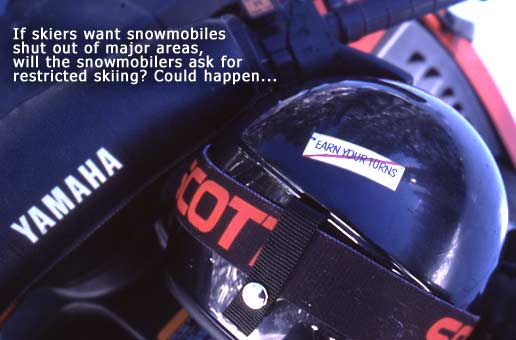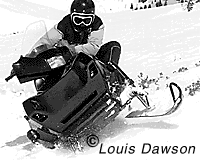(From Couloir Magazine Volume V, Number 4, April/May 1993, reworked 2009)

Family sledding and skiing, drawing by Louie Dawson 1998.
Crested Butte, Colorado. Lisa and I grab a gut-bomb at a cafe, then meet three friends at a trailhead. Our sport plan: Backcountry freshies in the epic midwinter snow of this high mountain town. We begin our trip with a snowmobile ride, as about 25 other skiers do. We’d still earn our turns as backcountry skiers. But we’d let our “sled” take the pain out of the approach slog, and help us escape the crowded lands close to the trailhead. Sound unusual? Not in Crested Butte, and not in other areas. Many backcountry skiers, rejecting restrictive ski area boundaries and costly helicopters, have discovered the snowmobile.
North American backcountry skiing and the snowmobile are joined at the hip. In Washington and California, skiers use the machines to aid travel to remote huts. In my neck of the woods, our groomed snowmobile routes, (known as “over-snow roads”) are popular with the nordic ski skating crowd.
Such grooming is paid for by snowmobile registration fees, while skiers pay little or nothing for their use. Snowmobilers work hard for trailhead parking, access and trail marking. Just as we skiers do, snowmobilers love the winter backcountry. Senior citizens, disabled people and many others do hut trips supported by snowmobiles. I’ve met one guy, a paraplegic, for whom snowmobiling is the equivalent of performance backcountry skiing. For skiers who can’t afford guides who store bedding and food at the huts, hauling baggage by machine to these huts is a fair option. Upkeep of many huts requires the use of snowmobiles. Virtually all rescue of backcountry skiers involves snowmobiles. Yet some backcountry skiers feel snowmobiles are nothing less than machines from hell.
Snowmobiles make noise — they make a heck of a lot more noise than a skier. Older sleds are terribly noisy. I used to own one, and it embarrassed me. Newer models are quieter than most skiers realize. Indeed, some could use a horn! But they still break the solitude. We have the technology to make the machines as quiet as a modern automobile, but noise standards set by the snowmobile industry are not that stringent. Yet snowmobiles are not the only noise offender. One Valentines day a few years ago, Lisa and I climbed a peak near a major snowmobile trailhead. All was peace. Then the dog teams showed up for a race that started at the trailhead. Their canine howls echoed through the valley and drowned out the faint buzzing of a few snowmobiles. They finally quit, then several airplanes flew over, then a jet roared. Other skiers howled as they cut the powder above us. Even if we’d skied in legal Wilderness, we could have heard the dogs and the aircraft. (While I’m sure the skiers would have been silent in their deep reverence for wilderness).
But even with a few noise episodes our day of skiing was a fine one. We came back with the rosy glow from a good climb. The view from the summit was still inspiring, the powder deep, and the jays still stole our picnic goods. True multiple use — we even shared our food!
But we can share thoughtfully. Neither skiers nor sledders can deny that it is grim to share a narrow trail with frequent traffic. This is rare, but it will happen more as both sports gain popularity. Such trails should be widened, have their use limited, or have parallel trails marked for skiers. Also, I’ve heard of huts being circled by snowmobilers like wild Indians attacking wagon train. That’s unacceptable and must stop. Ski areas don’t allow recreational snowmobiling on their ski slopes, and most huts on Federal land are nothing less than pygmy ski areas. Snowmobilers should be allowed to use the huts, but they must walk in a few hundred yards from the permit area boundary. Still another way to control use of huts is to build them where sleds can’t reach them (as many huts are). Not doing so, then trying to segregate use of public land, exhibits an arrogant attitude on the part of hut designers and backcountry skiers — an attitude that I can’t help but question when there are so many higher and more inaccessible places where huts could be built (though such locations increase the cost of truck supported summer maintenance — and snowmobile supported winter maintenance).
A few years ago I spent a winter disabled with an ankle problem. I could only walk a few hundred feet. As a way of enjoying the winter wild, I spent the season snowmobiling around Colorado. Riding mostly on established routes, and spending a lot of time picnicking and sight seeing, I truly enjoyed myself. I also had an interesting experience with bigotry. While we were unloading our sleds at a trailhead, a few backcountry skiers showed up. As one of them myself, I thought nothing of strolling over to their trucks and striking up a conversation. “Hi, how was the skiing?” I asked. Silence. “Hi,” I said again. A mumbled hi and averted eyes was their only reply. I could tell there was something weird going on. “At least we didn’t see any snowmobiles,” someone finally said as they threw their skis in the back of their truck and jumped behind the wheel. I stood and breathed their exhaust as they drove away. This was an eye opener. Just having a snowmobile on a trailer had converted me into a subhuman in these people’s eyes. They were skiing bigots! I vowed after that experience to never fall into the same mindset, no matter what side of the fence I’m on.
Should we reserve a few trails for skiers? Perhaps, but must ski trails follow the same snow covered roads and improved trails that sledders like? A ski trail can go anywhere you point your tips. Yet most skiers who whine about snowmobiles don’t hesitate to follow a nicely packed sled track. Why don’t they break a new trail? What’s more, why aren’t they skiing the thousands of miles of trails in our legal Wilderness? In the latter case, is the answer that Wilderness precludes huts, easy access, and well marked trails? If so, it’s elitist to ask snowmobilers to stay away while we improve non-wilderness lands for backcountry skiing. In view of any honest environmentalist, a snowmobile or ski hut are equal intrusions in the natural order — and the hut is a permanent degradation compared to the momentary visit of a snowmobile.
Machines from hell? Let us reexamine such vehement feelings. Is there an element of bigotry here; of tribalism? Should we be dividing multiple use lands so each use has it’s own area? If we restrict snowmobilers, in a draconian twist they could restrict skiers. I value my right to ski virtually all federal land — and I’m not alone in that feeling. Should snowshoers have their own trails? Dog teams? The handicapped? Kite flyers? The pie can only be cut so many times, and as the proverb says, “he who divides gets the worst share.”
Moreover, let’s not forget that snowmobiles are already restricted in millions of acres of legal wilderness across North America. Furthermore, snowmobiles simply can’t go everywhere a skier can, and thus are further limited. And finally, the snowmobile community has been more than accommodating by working to help arrange segregated use in crowded areas such as Alaska’s Turnagain Pass and Colorado’s Vail Pass. Would skiers do the same, and volunteer not to ski at a popular area so they wouldn’t bother snowmobilers? For example, would skiers volunteer to not ski routes on Mount Baker in Washington or Red Lady Peak in Crested Butte, both popular snowmobile areas? I think not, and I hope not!
But if skiers keep asking snowmobilers to limit their use of non-wilderness lands, why shouldn’t the sledders ask the same of the skiers? Thus far, the off highway vehicle (OHV) community has not taken this approach; but such segregation should loom as a possibility in any backcountry skier’s mind! By not practicing bigotry, but rather being inclusive, we can ward off any such occurrence.
We skiers and snowmobilers have more common ground than conflict. Let’s work together. As a team, we could fight threats to all backcountry users — threats such as development, trailhead vandalism, parking limits, and plowing of roads usually closed in winter and used as over-snow routes. Working together, we could insure kinder wilderness boundaries — instead of those forced by fanatics who view huts and snowmobiles with equal disdain. Working together, we could mark a few “skier only” trails off the snow covered roads that sledders like. Working together, we could can get manufacturers to make quiet machines. Working together, we could simplify winter hut maintenance by using appropriate snowmobile transport. Combine forces– we can make things happen!
WildSnow.com publisher emeritus and founder Lou (Louis Dawson) has a 50+ years career in climbing, backcountry skiing and ski mountaineering. He was the first person in history to ski down all 54 Colorado 14,000-foot peaks, has authored numerous books about about backcountry skiing, and has skied from the summit of Denali in Alaska, North America’s highest mountain.


